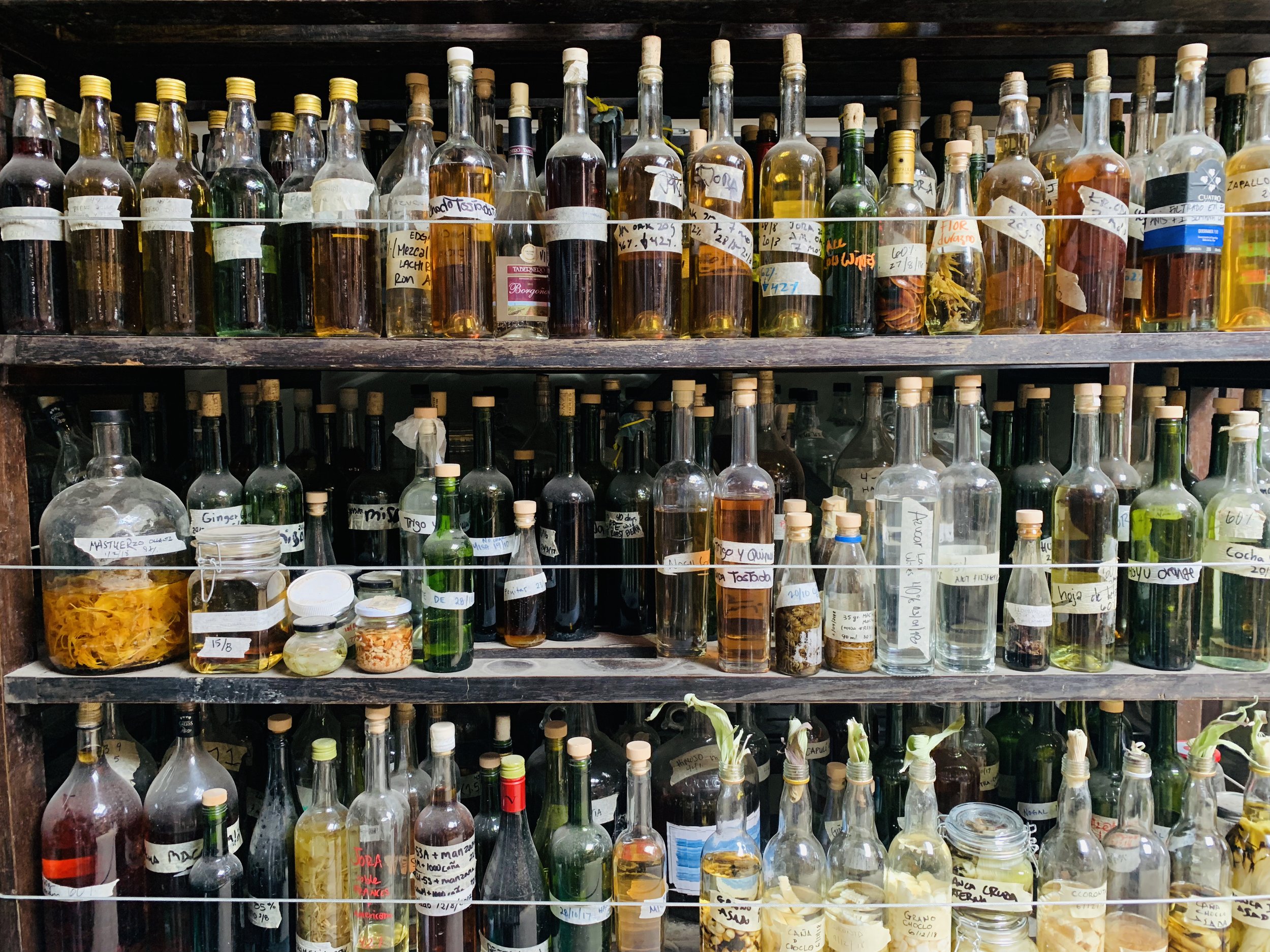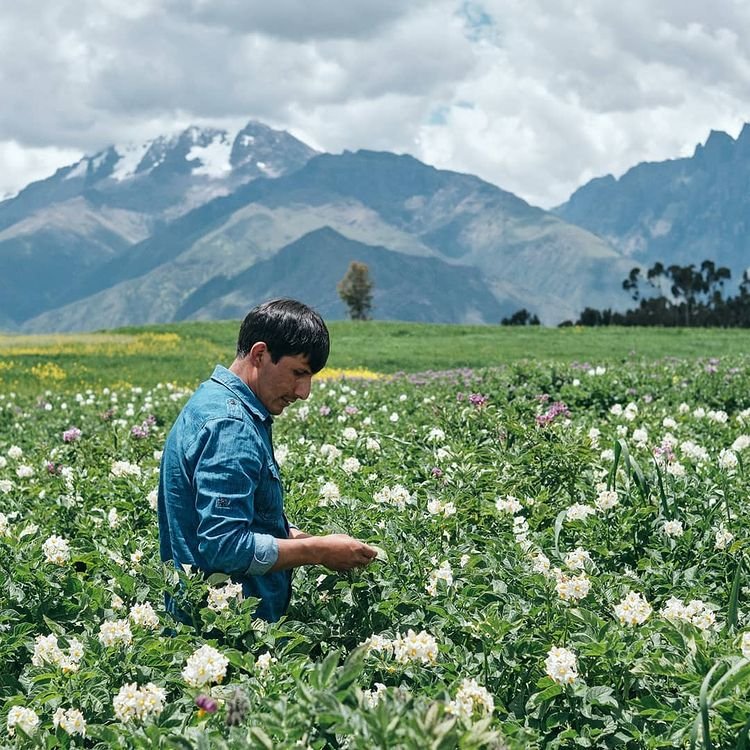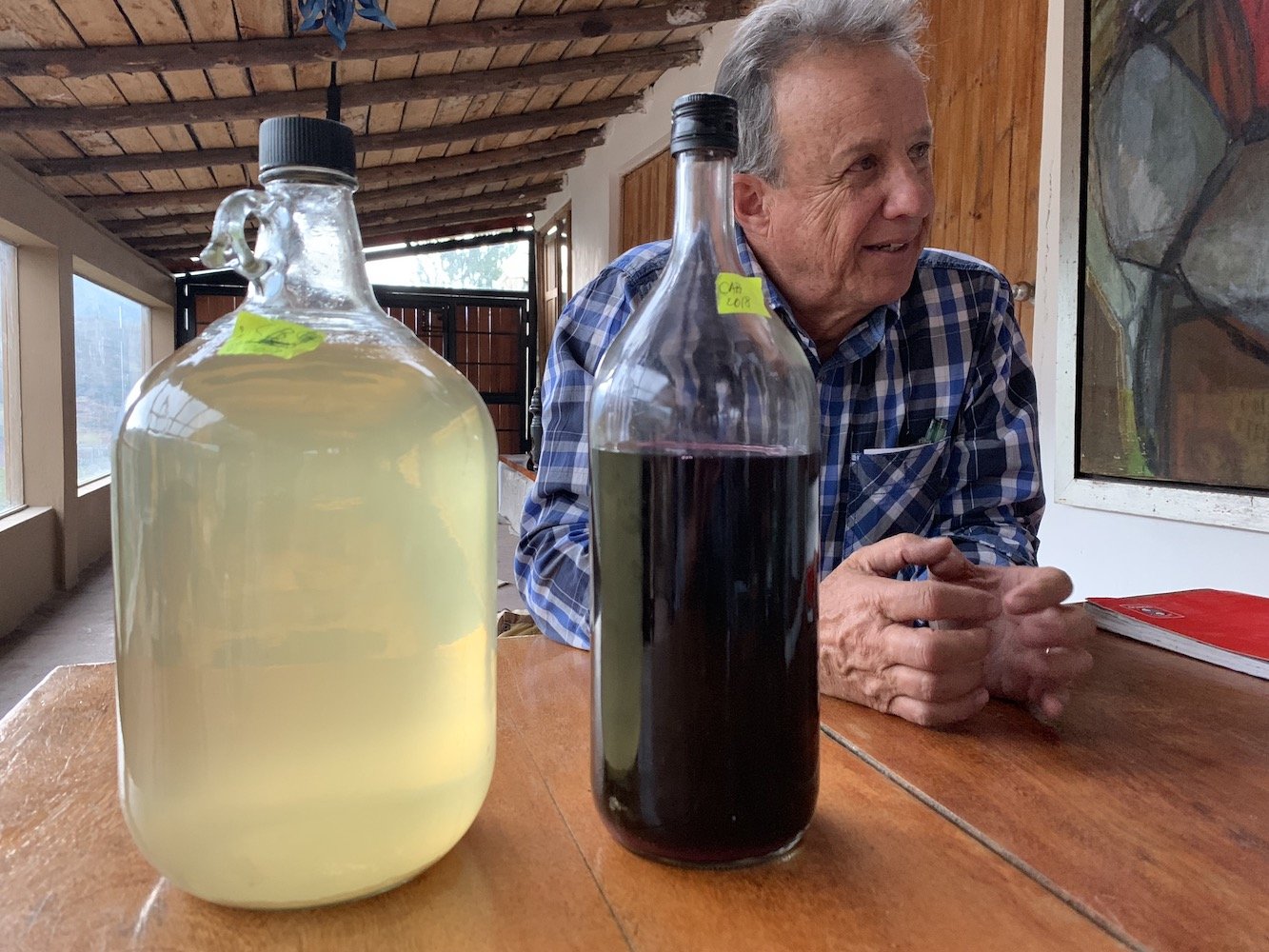The Spirits of the Andes
Text and Photos by Nico Vera
From left to right, apprentice Benji Miscano, distiller Rony Espinoza, farmer Isac Riquelme, distiller Haresh Bhojwani, blender André Querol and project director Joaquin Randall stand outside Destilería Andina in Ollantaytambo. Photo by Ines Gallegos.
At the foothills of the Inca ruins in Ollantaytambo, some 9,200 feet above sea level, sits Destilería Andina—a distillery that uses traditional methods and local ingredients to craft spirits that embody the terroir of the surrounding Sacred Valley and beyond. Fresh-pressed sugarcane juice from the Amazon is double-distilled into a cañazo rum. A high-elevation winery’s leftover grape pomace finds new life in an Old World orujo. Ancestral Andean jora corn transforms into unaged whiskey. And category-defying oca wine becomes a high-proof tuber brandy. Born from the collaboration between a distiller, winemaker, brewer and farmer, these distillates are the new spirits of the Andes.
Compuesto
When former New York-based lawyer Haresh Bhojwani visited Ollantaytambo, he sipped a compuesto that changed his life. These herbal liqueurs are in every home here. Families make them by infusing cañazo rum from local haciendas with native medicinal plants to define their color, aroma and flavor.
“Here was this complex, incredible homemade concoction. It was so personal because it represents what their mother likes,” says Bhojwani about the compuesto that Wendy Weeks made from her family recipe at El Albergue, her hotel adjacent to the town’s train station. “It was so lovely, it should be made for the whole world to drink,” he adds.
Over the next two decades, Bhojwani kept coming back to chat with Joaquin Randall, Weeks’ son, about producing the family’s compuesto. Unable to find a local cañazo they liked for the project, Bhojwani realized they had to distill their own and founded Destilería Andina. As it turns out, their new cañazo so strongly represented the terroir of the region, that they ended up bottling it on its own.
Destilería Andina sources cañazo from two regions, the high-elevation Andes and lower-elevation Amazon. Spirits are infused with local ingredients. Photo by Nico Vera.
Cañazo
Spain’s colonial foodways brought caña de azucar (sugarcane) to Peru’s north coast more than 400 years ago. In the tradition of the French Caribbean's rhum agricole, locals began distilling fresh-pressed sugarcane juice to make cañazo. Because it’s more economical to produce than pisco, Peru’s grape brandy, cañazo became the drink of the working class, especially in the Andes where families pour it on the ground as an offering to Pachamama, Mother Earth.
Peru’s cañazo producers distill only once, but Destilería Andina’s does it differently.
“I believe in the double-distillation symphony,” Bhojwani says. The first distillation extracts the alcohol from the fermentation, and the second focuses on the flavors. However, instead of starting with sugarcane, Destilería Andina uses producers’ once-distilled cañazo and distills it again to obtain their product.
Destilería Andina sources cañazo from two regions, the high-elevation Andes and lower-elevation Amazon, different ecosystems that shape Peru’s vertical ecology.
In Curahuasi, not far from Ollantaytambo, the glacial river Apurimac cuts through former Andean seabeds. Its water, rich in minerals and salinity, irrigates crops in the arid environment. At this altitude, more than 8,000 feet, it takes about 18 months for the sugarcane to mature, and Bhojwani describes the taste of their high-elevation cañazo as “reminiscent of green olives, almost like a dirty martini.”
Just a couple of hours from Ollantaytambo, dropping a few thousand feet into the edge of Peru’s Amazon, the soil is fertile in plant matter and manure from local farms. The sugarcane that grows here matures in just six months. This makes their younger lower-elevation cañazo “funky, more like a traditional rhum agricole,” Bhojwani says.
After three years of experimenting, Destilería Andina settled on a recipe for the family’s compuesto. For the base, they chose their higher-elevation cañazo, which Bhojwani believes has the right minerality and salinity to bond botanical flavors together and create a little bit of sweetness from fresh herbs like fennel and chamomile flowers. But despite having successfully produced the compuesto that inspired Bhojwani’s move to Ollantaytambo, Destilería Andina was just getting started.
Traditionally, women make chicha de jora. Here, they also drink it in Ollantaytambo. Photo by Álvaro Balcázar.
Whiskey de Jora
In the outskirts of Ollantaytambo, Cervecería del Valle Sagrado is brewing some of Peru’s first small-batch craft beer. But thousands of years ago, Andean communities were already germinating corn into jora to make the ancestral chicha de jora beer.
“It’s 8,000 years of fermentation behind that grain. So, it’s knowledge handed down mother to daughter for 8,000 years,” says Bhojwani about jora, and the chicheras (women brewers) who traditionally make chicha de jora.
To some, it’s an acquired taste, as the chicha de jora beer is actively fermenting when you drink it. But to Juan Mayorga, Cervecería del Valle Sagrado founder, “It’s a really nice, unfiltered, wonderful light sour, with a lot of chewiness and body to it, like a big wheat beer, with a light frothiness to it.”
The aroma of open-air wild fermentation of chicha de jora, in chomba earthenware vats, fills the dirt-floor rooms in the adobe homes that are chicherías. Ubiquitous throughout the Sacred Valley, these chicherías announce a freshly brewed batch by flying a red bag on a large stick outside their door.
“It used to be red flowers, so you could see how new that batch was by the freshness of those flowers,” Mayorga says.
Cervecería del Valle Sagrado imports malts and hops from as far as Germany or Oregon, then adds native ingredients such as passion fruit, prickly pear seeds, squash, cacao nibs or coffee to infuse pale ale, red ale, saison and sour beers with Peruvian flavors. The process for brewing craft beer in a modern facility is controlled and consistent yet fundamentally the same as making chicha de jora.
For chicha de jora, germinated corn is milled, boiled, strained, then fermented for about three days. But because the corn’s origin can change daily and uncontrolled fermentation introduces variables such as fluctuating ambient temperature, chicha de jora can taste different from one day to the next, even at the same chichería.
Inspired by the ancient grain, Bhojwani and Mayorga wanted to know what a jora whiskey would taste like. The first step in their collaboration was sourcing the jora.
In Ollantaytambo, Tomasa and Juliana use their generational knowledge to brew chicha de jora like their ancestors. In their rustic chichería, they serve large caporal glasses of chicha de jora, straight from their open fermentation vats. The beer is best fresh, so they continuously make new batches for their local customers. Mayorga sources jora for the whiskey here.
To distill whiskey de jora, Destilería Andina follows the bourbon recipe—a 50% jora and 50% malt mash that they double-distill into an unaged, clear whiskey.
“Instead of oak, it tastes like corn, like that smell of tamales, that moist, earthy, mother's kitchen beautiful comforting smell,” Bhojwani says.
Corn is one of the most important crops in the Peruvian Andes, alongside potatoes and other tubers like oca. But Bhojwani never imagined he would meet someone who was making an oca wine, much less that someday he would be distilling it into oca brandy.
Manuel Choqque stands in his potato field in Huatata, at an elevation of 12,270 feet. Photo by Antonio Sorrentino
Oca Brandy
In Huatata, an hour outside of Cusco and at an elevation of 12,270 feet, Indigenous farmer and agricultural engineer Manuel Choqque has been researching the crops of his ancestors for the past 15 years. “Our project consists of rescuing forgotten tubers like potato, oca, and mashua,” says Choqque of his mission.
He remembers that when he was a child, his father would give him raw oca to eat, much like an apple. That made Choqque think of oca as a fruit with a natural sweetness to it. Then, a fateful conversation with friends lead to a question: Is it possible to make wine from any sweet fruit? So, after returning home, Choqque began to evaluate and classify oca that could be fermented into wine.
“Of the 1,900 varieties of oca, we have 60 in our collection and then chose 10 for fermenting,” Choqque says of the oca varieties that had between 20 and 22 degrees Brix, ideal for converting the fruit into alcohol. To increase sugar levels, Choqque implements an ancestral technique—he soaks oca in water, exposes it to the high-elevation sun and crushes the tuber. Then he applies traditional winemaking methods.
When sommeliers first tasted Choqque’s oca wine, they asked him, “Is this Sauvignon or Chardonnay? What grape varietal is this?” But Choqque’s goal is not to replace or substitute grape wine, rather create a new category he calls oxalis, after the scientific name for oca. Through these sommeliers, Choqque met Bhojwani, who naturally invited him to visit Destilería Andina.
Bhojwani double-distills Choqque’s oca wine into an aguardiente or brandylike spirit that Choqque compares to an “aromatic pisco, generous, full-bodied, yet subtle, with the aroma of white flowers and herbs.” He attributes its complexity to the late oca harvest.
“The more time the oca is underground, the more rich it becomes in terms of texture, aroma, and minerality,” Choqque says.
On a visit to Destilería Andina, Bhojwani offered Choqque some cañazo to gift to his parents. In the trueque tradition, Choqque returned the favor by gifting Bhojwani some of his potatoes.
“By rescuing the trueque, we are cultivating friendship and a closeness that has been lost nowadays,” says Choqque, hoping to encourage other agricultural producers to participate in the practice.
Fernando Gonzalez-Lattini hopes to revive the tradition of winegrowing and making in Curahuasi. Here, he shows his 2018 Sauvignon Blanc. Photo by Nico Vera.
Orujo
Curahuasi, the origin of Destilería Andina’s high-elevation once-distilled cañazo, is also the source for grapes. It was colonial foodways that carried grapes to the Viceroyalty of Peru, one of the first wine-producing regions in the Americas. Though most of Peru’s wineries are located near the coast south of Lima, Curahuasi was once home to early vineyards. Winemaker Fernando Gonzalez-Lattini seeks to revive that tradition here.
Named after mountain gods that protect crops in the Andes, Gonzalez-Lattini’s Apu Winery is one of the highest in the world, and rows of vines line the terraced mountainside. In 2017, its first vintage included Sauvignon Blanc.
Apu Winery’s process involves harvesting the grapes, removing the stems, then pressing the grapes to separate the skin and seeds in order to obtain the juice that’s fermented into wine. Committed to a no-waste winemaking approach, the business collaborated with Destilería Andina to distill the pomace, or the leftover crushed grape skin and seeds.
But there was a deeper inspiration—Gonzalez-Lattini’s Italian heritage. His great-grandfather hailed from Italy’s winemaking region of Le Marche, and imbibing grappa was a family tradition.
“They used to drink grappa after Sunday lunch meals,” he says. Out of respect for grappa’s heritage, Gonzalez-Lattini opted for the term orujo, the name for Spain’s pomace brandy.
To prepare the pomace for distillation, Apu Winery adds fruits, sugar, water and yeast to the leftover grape skin and seeds to ferment the mixture. From there, Destilería Andina takes over.
“Because we are distilling at altitude, things don’t burn in the still, alcohol is evaporating at a lower temperature,” Bhojwani says. “So, the orujo tastes very much like the wine, and where it comes from.”
“You can really taste grapefruit and smell the aroma of jasmine or eucalyptus,” says Gonzalez-Lattini about their Sauvignon Blanc orujo. It’s the Andean terroir’s limestone soil and cool nights that give grapes here their high acidity and minerality.
This orujo, together with the compuesto, cañazo, whiskey de jora, and oca aguardiente represent diverse spirits, producers, and ingredients throughout the Andes, yet they are intimately connected by one place—Destilería Andina.
It was important to Haresh Bhojwani that Destilería Andina’s copper pot stills be traditionally made, so he traveled to Portugal to get them. Photo by Nico Vera.
Destilería Andina
Surrounded by mountains and tucked behind El Albergue’s farm, the wood shack with horizontal planks, cement floor and corrugated metal slanted roof that houses Destilería Andina blends in with Ollantaytambo’s rustic environment. Inside, the space looks like a well-used laboratory. Two large copper pot stills sit majestically opposite the sliding door entrance, and hand-labeled bottles with earthy-looking spirits infused with various native ingredients fill dusty wood shelves along the walls.
It was important to Bhojwani that Destilería Andina’s copper pot stills be traditionally made, so he traveled to Portugal to get them.
“I think they're essentially the same shape of still that North Africans brought to Spain,” Bhojwani says. “They're hand hammered, and the same families in the same regions have been making these probably for 1,500 years.”
These copper pot stills are versatile and have been used for generations to distill ancestral spirits like eau de vies and aguardientes from any fruits that are in season. But they are not automated. It requires skill to control the heat source, gas-fueled ring-shaped paella-pan burners, that slowly cooks the fermentations for distilling into spirits.
Bhojwani believes that the high elevation here is an important factor that gives the spirits their delicate notes and makes them taste more like the original ingredients they are distilled from.
“When you cook a spaghetti sauce at altitude, it takes forever for the tomatoes to break down, so it tastes a little raw,” Bhojwani says. “The potatoes are still a little al dente. So that has to be happening with the fermentation.”
Between 2018 and 2019, I traveled to the Sacred Valley and visited Destilería Andina, Cervecería del Valle Sagrado, Apu Winery and Mil, a restaurant that prepares dishes from Andean ingredients foraged at different elevations. I’ve sipped the compuesto, cañazo, chicha de jora, whiskey de jora, oca wine, high-elevation grape wine and orujo. And I thought that each drink was unique on its own, but what I found to be more profound was how they were all connected.
What the distiller, winemaker, brewer and farmer have created here is a true collective, a spirited community working with native ingredients and ancestral techniques that honor the heritage of the Andes. These spirits could not exist anywhere else, for they are as unique as the people and terroir of the Sacred Valley. But for now, their small-batch production means you can only find these spirits in Curahuasi, Cusco, Ollantaytambo or Lima.
Today, in my Portland home, I have a few bottles of these spirits that my fiancée and I brought back from our last trip to Peru in 2019. On special occasions, I take a few sips that connect me to my ancestors. And the aromas remind me of my spiritual and childhood home in the Andes mountains. So, once we run out, we’ll have to make a pilgrimage back to the Sacred Valley.






